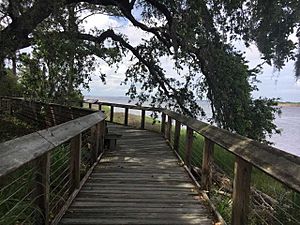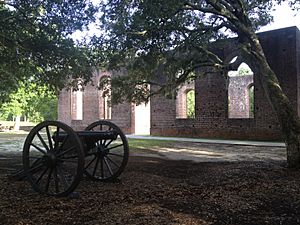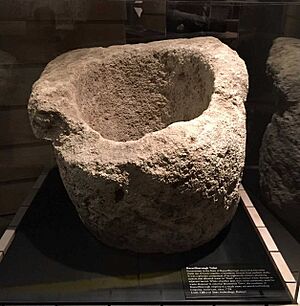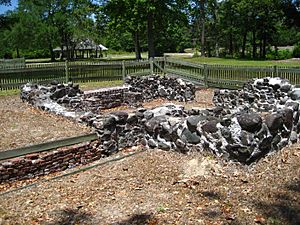Brunswick Town, North Carolina facts for kids

Brunswick Town was an important town in colonial North Carolina. It was the first successful European settlement in the Cape Fear region. This town was a busy port in the 1700s and home to two governors. Brunswick Town lasted for 50 years. It was burned in 1776 by British soldiers during the American Revolutionary War. The town was never rebuilt after that. Much later, during the American Civil War, parts of the town were covered by large dirt walls called earthworks. These were built for Fort Anderson.
Today, Brunswick Town is an exciting place to learn about history. You can see the remains of 1700s homes and shops. There are also the ruins of St. Philip's Church and Fort Anderson. You can also find the site of Russellborough, which was once a governor's house. The historic area and St. Philip's Church are special places. They are listed on the National Register of Historic Places.
Contents
How Brunswick Town Started
Before Brunswick Town was built, the area was home to the Cape Fear Native Americans. They helped the colonists fight against the Tuscarorans in the Tuscarora War (1711–15). Later, they fought against the colonists in the Yamasee War (1715–1717). In 1725, a man named Colonel Maurice Moore received 1,500 acres of land. He started Brunswick Town in June 1726. The very first piece of land was sold to Cornelius Harnett Sr.

Colonel Maurice Moore was the son of Governor James Moore. His family was very important in the area. The town was named after Brunswick-Lüneburg. This was a German area ruled by Great Britain's King George I. Many of the Moore family moved to Brunswick Town. They became known as "The Family."
Brunswick Town grew quickly and became a busy port. Ships exported products from longleaf pine trees. These included tar, pitch, and turpentine. These materials were important for the Royal Navy and other ships. By the 1730s, Brunswick Town was the main political center of the Cape Fear region. It was also the county seat for New Hanover County. The town was important because the Cape Fear River was too shallow further upstream for large ships. Brunswick Town was also the third capital city of the Province of North Carolina. This meant the governor lived there from 1743 to 1770.
Spanish Attack on Brunswick Town
Over the years, Brunswick became North Carolina's busiest port. It shipped goods to Europe and the British West Indies. England was often at war with Spain and France. The Cape Fear area was a good target for enemy attacks. From September 3–6, 1748, Spanish privateers attacked Brunswick Town. Privateers were like pirates, but they had permission from their government to attack enemy ships. Two Spanish ships, La Fortuna and La Loretta, anchored near the town.
The townspeople were scared and ran into the nearby woods. On September 4, 1748, the Spanish began to raid the town. They looked for slaves and valuable items. Since everyone had left, the Spanish easily raided the empty ships and houses.
On September 5, Captain William Dry III gathered about 67 men. They had muskets and pistols. On September 6, they started a counterattack. A slave volunteered by George Ronalds also joined the fight. The Spanish quickly fled from the town. Ten privateers were killed, and thirty were captured. During their escape, La Fortuna exploded, killing most of the men on board. The second ship, La Loretta, surrendered. Only one person defending the town died. This was the slave who had volunteered.
The abandoned ship, La Fortuna, was still in the river. William Dry III hired sailors to search it for valuables. They found guns, anchors, and items stolen from the town. They also found a painting of the Ecce Homo. This painting was given to St. James Church, Wilmington. It is still there today. The town sold the captured Spanish slaves and goods from the ship. The money from these sales helped build St. Philip's Church and St. James Church.
Russellborough: A Governor's Home
Russellborough was a large, two-story house and plantation. Royal Governor Arthur Dobbs bought the land in 1758. He made some changes and finished the house, calling it "Castle Dobbs." After Governor Dobbs died in 1765, William Tryon became the new governor. Governor Tryon moved into the house, calling it "Castle Tryon."
Later, Governor Tryon built a new house in New Bern, North Carolina. This is known as Tryon Palace. He then sold his Brunswick Town plantation to William Dry III. William Dry III renamed it Bellfont. In 1776, British forces burned the plantation.
When Fort Anderson was built, Russellborough was left untouched. Today, you can see the excavated ruins at Brunswick Town/Fort Anderson North Carolina State Historic Site. You can also see items found at Russellborough in the visitor center.
Standing Up to the Stamp Act
On November 1, 1765, the British Parliament passed the Stamp Act. This law made colonists pay a tax on many printed materials. That same month, a British ship arrived at the port with the tax stamps. However, angry citizens of Brunswick Town met the captain. They refused to let the stamps off the ship. Governor Tryon tried to calm everyone down, but he wanted to enforce the law.
In February 1766, two more ships arrived. They did not have the special stamp clearance. Because of this, they were not allowed to unload their goods. On February 20, 1766, important leaders like John Ashe and Cornelius Harnett led hundreds of citizens. They went to arrest royal officials in the town. The patriots also surrounded the governor's home. They were protesting the Stamp Act of 1765 and put Governor Tryon under house arrest. This protest was one of the first times colonists used strong resistance against British rule. It stopped the stamp tax from being collected in the Cape Fear region.
Why Brunswick Town Disappeared
Wilmington grew bigger and more important. Governor Tryon also moved to his new palace in New Bern. Because of these things, Brunswick Town slowly became less important.
By 1775, the few families still living in Brunswick Town left. They were afraid of a British attack during the American Revolutionary War. In the spring of 1776, British soldiers from the Royal Navy ship HMS Cruizer attacked Brunswick Town. They burned most of the town's buildings, including Russellborough and likely St. Philip's Church. Later, British generals ordered parts of the town to be burned again. After the war, only a few families returned. The port still worked for a while. But by 1830, the town site was completely empty. It was sold for a very small amount of money.
In March 1862, soldiers from the Confederate States Army looked at the remains of Brunswick Town. The Confederates built large dirt walls and trenches on the town site. These covered the remains of several burned buildings, except for St. Philip's Church. The fort was built to protect Wilmington, a vital port during the Civil War. The fort was first called Fort St. Philip. It was renamed Fort Anderson in July 1863. During an attack on Fort Anderson in February 1865, cannonballs from Union ships hit the walls of St. Philip's Church. You can still see the marks today.
Discovering the Past: Excavation
In 1899, a group called the Cape Fear Chapter of the North Carolina Society of The Colonial Dames of America visited Brunswick Town. They wanted to honor those who died in the Revolutionary War. In 1902, they placed a marble plaque inside the roofless ruins of St. Philip's Church. This plaque honored Maurice Moore, who founded Brunswick Town.
In 1952, Dr. Lawrence Lee Jr. became interested in Brunswick Town. He believed the site should be dug up to find its history. In 1958, Dr. Lee was hired to clear the land and find the town's ruins. He asked for help from an archaeologist named Stanley South. Stanley South began digging extensively in 1958. He found items like bullets, buttons, and a cannonball inside the St. Philip's Church ruins. Today, the remains of Brunswick Town are a state historic site. Visitors can explore the town's ruins and the earthworks of Fort Anderson.




